Comparative Analyses of Anatomical Structure, Phytohormone Levels, and Gene Expression Profiles Reveal Potential Dwarfing Mechanisms in Shengyin Bamboo (Phyllostachys edulis f. tubaeformis)
Abstract
1. Introduction
2. Results
2.1. Comparison of Phenotypic Characteristics of Dwarf Shengyin Bamboo and Wild Moso Bamboo
2.2. Vascular Anatomical Trait Observations
2.3. Global Changes in Candidate Gene Expression during Shoot Development in Dwarf Shengyin and Wild Moso Bamboo
2.4. DEGs Involved in Cell Wall Biosynthesis and Expansion
2.5. DEGs Involved in Phythormone Biosynthesis and Signal Transduction Pathways
2.6. Endogenous Hormone Concentrations
3. Discussion
3.1. Cell Wall Components and Internode Length
3.2. The Role of Plant Hormones in Determining Internode Length
4. Conclusions
5. Materials and Methods
5.1. Plant Materials
5.2. Phenotypic Investigations
5.3. Anatomical Characteristics
5.4. cDNA Library Construction and Transcriptome Sequencing
5.5. Quantification of Endogenous Hormones in Bamboo Shoots
Supplementary Materials
Author Contributions
Funding
Conflicts of Interest
Abbreviations
| 4CL | 4-coumarate-CoA ligase |
| ABA | Abscisic acid |
| ACO | Acyl-CoA oxidase |
| AOC | Allene oxide cyclase |
| AOS | Allene oxide synthase |
| BR | Brassinosteroid |
| brd1 | BR-deficient dwarf 1 |
| BRI1 | Brassinosteroid Insensitive 1 |
| BZR1 | BRASSINAZOLE-RESISTANT 1 |
| C3H | Coumarate-3-hydroxylase |
| CCR | Cinnamoyl-CoA reductase |
| CES | Cellulose synthase |
| CSL | Cellulose synthase-like genes |
| D2 | A rice dwarf mutant, dwarf2 |
| DEG | Differentially expressed genes |
| DELLA | D-aspartic acid, E-glutamic acid, L-leucine, A-alanin |
| EPS1 | Enhanced pseudomonas susceptibility 1 |
| EXP | Expansin |
| F5H | Ferulate 5-hydroxylase |
| GA | Gibberellin acid |
| GAI | Gibberellin acid insensitive |
| GASA | GA-Stimulated in Arabidopsis |
| GO | Gene ontology |
| GID1 | GIBBERELLIN INSENSITIVE DWARF 1 |
| HCT | p-hydroxycinnamoyl-CoA:quinate/shikimate O-hydroxycinnamoyltransferase |
| IAA | Indole-3-acetic acid |
| IPA | Indole-3-pyruvic acid |
| JA | Jasmonic acid |
| LN | Arithmetic mean length |
| LOX | Lipoxygenase |
| LW | Length-weighted mean length |
| LWW | Length-weighted average fiber length |
| MYC2 | Myelocytomatosis protein 2 |
| MZA | Top internodes of wild moso bamboo |
| MZB | Middle internodes of wild moso bamboo |
| MZD | Basal internodes of wild moso bamboo |
| NCED | 9-cis-epoxycarotenoid dioxygenase |
| NPR1 | Nonexpressor of pathogenesis-related genes 1 |
| OPR | OPDA reductase 7 |
| PA | Pectin acetylesterase |
| PAL | Phenylalanine ammonia-lyase |
| PG | Polygalacturonase |
| PL | Pectate lyase |
| PM | Pectinesterase |
| SA | Salicylic acid |
| SABP | SA binding protein |
| SYa | Top internodes of dwarf shengyin moso bamboo |
| SYb | Middle internodes of dwarf shengyin moso bamboo |
| SYd | Basal internodes of dwarf shengyin moso bamboo |
| XYL | Xylosidase |
| XTH | XYLOGLUCAN endotransglucosylase/hydrolase |
References
- Ma, N.; Lai, G.; Zhang, P.; Zhang, H. The Genus Phyllostachys in China; Zhejiang Science and Technology Publishing House: Hangzhou, China, 2014. [Google Scholar]
- Jiang, Z.H. Bamboo and Rattan in the World; Liaoning Science and Technology Publishing House: Shenyang, China, 2002. [Google Scholar]
- Cui, K.; He, C.; Zhang, J.; Duan, A.; Zeng, Y. Temporal and spatial profiling of internode elongation-associated protein expression in rapidly growing culms of bamboo. Proteome Res. 2012, 11, 2492–2507. [Google Scholar] [CrossRef] [PubMed]
- Li, L.; Cheng, Z.; Ma, Y.; Bai, Q.; Li, X.; Cao, Z.; Wu, Z.; Gao, J. The association of hormone signaling genes, transcription, and changes in shoot anatomy during Moso bamboo growth. Plant Biotechnol. J. 2018, 16, 72–85. [Google Scholar] [CrossRef] [PubMed]
- Lao, X.; Azuma, J.; Sakamoto, M. Two cytosolic aldolases show different expression patterns during shoot elongation in Moso bamboo, Phyllostachys pubescens Mazel. Physiol. Plantarum. 2013, 149, 422–431. [Google Scholar]
- Cui, K.; Wang, H.; Liao, S.; Tang, Q.; Li, L.; Cui, Y.; He, Y. Transcriptome sequencing and analysis for culm elongation of the world’s largest bamboo (Dendrocalamus sinicus). PLoS ONE 2016, 11, e0157362. [Google Scholar] [CrossRef] [PubMed]
- He, C.; Cui, K.; Zhang, J.; Duan, A.; Zeng, Y. Next-generation sequencing-based mRNA and microRNA expression profiling analysis revealed pathways involved in the rapid growth of developing culms in Moso bamboo. BMC Plant Biol. 2013, 13, 119. [Google Scholar] [CrossRef] [PubMed]
- Rico, G.; Keisuke, N.; Madoka, A.; Yoshinao, M.; Anzu, M.; Mikiko, K.; Takamasa, S.; Hitoshi, S.; Tetsuya, H.; Motoyuki, A.; et al. Hormone Distribution and Transcriptome Profiles in Bamboo Shoots Provide Insights on Bamboo Stem Emergence and Growth. Plant Cell Physiol. 2017, 58, 702–716. [Google Scholar]
- Chung, Y.; Choe, S. The regulation of brassinosteroid biosynthesis in Arabidopsis. Crit. Rev. Plant Sci. 2013, 32, 396–410. [Google Scholar] [CrossRef]
- Kovi, M.R.; Zhang, Y.; Yu, S.; Yang, G.; Yan, W.; Xing, Y. Candidacy of a chitin-inducible gibberellin-responsive gene for a major locus affecting plant height in rice that is closely linked to green revolution gene sd1. Theor. Appl. Genet. 2011, 123, 705–714. [Google Scholar] [CrossRef] [PubMed]
- Tong, H.; Liu, L.; Jin, Y.; Du, L.; Yin, Y.; Qian, Q.; Zhu, L.; Chu, C. DWARF and LOW-TILLERING acts as a direct downstream target of a GSK3\SHAGGY-like kinase to mediate brassinosteroid responses in rice. Plant Cell 2012, 24, 2562–2577. [Google Scholar] [CrossRef] [PubMed]
- Zhao, J.; Wu, C.; Yuan, S.; Yin, L.; Sunc, W.; Zhao, Q.; Zhao, B.; Li, X. Kinase activity of OsBRI1 is essential for brassinosteroids to regulate rice growth and development. Plant Sci. 2013, 199, 113–120. [Google Scholar] [CrossRef] [PubMed]
- Patzak, J.; Dobrev, P.I.; Motyka, V. Endogenous phytohormone levels in dwarf and normal hop (Humulus lupulus) plants. Acta Hortic. 2013, 3, 141–148. [Google Scholar] [CrossRef]
- Guerriero, G.; Fugelstad, J.; Bulone, V. What do we really know about cellulose biosynthesis in higher plants. J. Integr. Plant Biol. 2010, 52, 161–175. [Google Scholar] [CrossRef] [PubMed]
- Wang, W.; Tan, Y.; Wang, C.; Liu, X. Effects of Glycosyltransferase Gene sm-Ngt1 on the Plant Height of Rice. Agric. Sci. Technol. 2011, 12, 1279–1282. [Google Scholar]
- Tang, L.; Chen, J. Study on tissue culture technique of Phyllostachys pubescens cv. Tubaeformis. China Hunan For. Sci Technol. 2009, 36, 23–24. [Google Scholar]
- Zhang, X.; Hu, A.; Cao, X. A study of introduction and cultivation technology of Phyllostachys heterocycla cv. Tubaeformis S.Y.Wang. World Bamboo Rattan 2010, 5, 23–27. [Google Scholar]
- Tang, H.; Liu, W.; Huang, T.; Jiang, L.; Huang, C.; Huang, W. Study on shooting and young bamboo height growth of Phyllostachys heterocyclain Hunan Forest Botanical Garden. China Cent. South Univ. For. Technol. 2015, 35, 27–31. [Google Scholar]
- Liu, C.; Wang, Y.; Pan, K.; Wang, Q.; Liang, J.; Jin, Y.; Tariq, A. The synergistic responses of different photoprotective pathways in dwarf Bamboo (Fargesia rufa) to drought and subsequent rewatering. Front. Plant Sci. 2017, 8, 489. [Google Scholar] [CrossRef] [PubMed]
- Peng, Z.; Lu, Y.; Li, L.; Zhao, Q.; Feng, Q.; Gao, Z.; Lu, H.; Hu, T.; Yao, N.; Liu, K.; et al. The draft genome of the fast-growing non-timber forest species moso bamboo (Phyllostachys heterocycla). Nat. Genet. 2013, 45, 456–461. [Google Scholar] [CrossRef] [PubMed]
- Xu, Z.; Zhang, D.; Hu, J.; Zhou, X.; Ye, X.; Reichel, K.L.; Stewart, N.R.; Syrenne, R.D.; Yang, X.; Gao, P.; et al. Comparative genome analysis of lignin biosynthesis gene families across the plant kingdom. BMC Bioinform. 2009, 10, S3. [Google Scholar] [CrossRef] [PubMed]
- Zhao, Q.; Dixon, R.A. Transcriptional networks for lignin biosynthesis: More complex than we thought. Trends Plant Sci. 2010, 16, 227–233. [Google Scholar] [CrossRef] [PubMed]
- Richmond, T.A. Somerville CR Integrative approaches to determining Csl function. Plant Mol. Biol. 2001, 47, 131–143. [Google Scholar] [CrossRef] [PubMed]
- Fry, S.C. Primary cell wall metabolism: Tracking the careers of wall polymers in living plant cells. New Phytol. 2004, 161, 641–675. [Google Scholar] [CrossRef]
- Zhao, Y.; Li, L. Plant Cell Wall Loosening Factors. China Plant Physiol. J. 2011, 47, 925–935. [Google Scholar]
- Gray-Mitsumune, M.; Blomquist, K.; McQueen-Mason, S.; Teeri, T.T.; Sundberg, B.; Mellerowicz, E.J. Ectopic expression of a wood-abundant expansin PttEXPA1 promotes cell expansion in primary and secondary tissues in aspen. Plant Biotechnol. J. 2008, 6, 62–72. [Google Scholar] [CrossRef] [PubMed]
- Chen, W.; Liu, Y.; Sun, Y.; Li, W.; Li, J. Research advances in cloning of dwarf genes in rice. China Henan Agric. Sci. 2017, 46, 1–7. [Google Scholar]
- Wasternack, C.; Hause, B. Jasmonates: Biosynthesis, perception, signal transduction and action in plant stress response, growth and development. Ann. Bot. 2013, 111, 1021–1058. [Google Scholar] [CrossRef] [PubMed]
- Zheng, Z.; Qualley, A.; Fan, B.; Dudareva, N.; Chen, Z. An important role of a BAHD acyl transferase-like protein in plant innate immunity. Plant J. 2009, 57, 1040–1053. [Google Scholar] [CrossRef] [PubMed]
- Li, M.; Xiong, G.; Li, R.; Cui, J.; Tang, D.; Zhang, B.; Pauly, M.; Cheng, Z.; Zhou, Y. Rice cellulose synthase-like D4 is essential for normal cell-wall biosynthesis and plant growth. Plant J. 2009, 60, 1055–1069. [Google Scholar] [CrossRef] [PubMed]
- Jiang, N. Study on Chemical Characterization in Tissue Cell of Moso Bamboo (Phyllostachrs pubescens) at Different Age; China Northeast Forestry University: Haerbin, China, 2011. [Google Scholar]
- Reiter, W. Biosynthesis and properties of the plant cell wall. Cell Biol. 2002, 5, 536–542. [Google Scholar] [CrossRef]
- Somerville, C.; Bauer, S.; Brininstool, G.; Hamann, M.F.T.; Milne, J.; Osborne, E.; Paredez, A.; Persson, S.; Ted, R.; Vorwerk, S.; et al. Toward a systems approach to understanding plant cell walls. Science 2004, 306, 2206–2211. [Google Scholar] [CrossRef] [PubMed]
- Jensen, J.K.; Schultink, A.; Keegstra, K.; Wilkerson, C.G.; Pauly, M. RNA-Seq analysis of developing nasturtium seeds (Tropaeolum majus): Identification and characterization of an additional galactosyltransferase involved in xyloglucan biosynthesis. Mol. Plant 2012, 5, 984–992. [Google Scholar] [CrossRef] [PubMed]
- Voegele, A.; Linkies, A.; Ller, KM.; Leubner-Metzger, G. Members of the gibberellin receptor gene family GID1 (GIBBERELLIN INSENSITIVE DWARF1) play distinct roles during Lepidium sativum and Arabidopsis thaliana seed germination. J. Exp. Bot. 2011, 62, 5131–5147. [Google Scholar] [CrossRef] [PubMed]
- Wang, G.; Gao, Y.; Wang, J.; Yang, L.; Song, R.; Li, X.; Shi, J. Overexpression of two cambium-abundant Chinese fir (Cunninghamis lanceolata) α-expansin genes ClEXPA1 and ClEXPA2 affect growth and development in transgenic tobacco and increase the amount of cellulose in stem cell walls. Plant Biotechnol. J. 2010, 9, 486–502. [Google Scholar] [CrossRef] [PubMed]
- Ueguchi-Tanaka, M.; Ashikari, M.; Nakajima, M.; Katoh, H.I.E.; Kobayashi, M.; Chow, T. GIBBERELLIN INSENSITIVE DWARF1 encodes a soluble receptor for gibberellin. Nature 2005, 437, 693–698. [Google Scholar] [CrossRef] [PubMed]
- Dong, J.; Yin, M.; Yang, F.; Zhao, J.; Qin, S.; Hou, L.; Luo, M.; Pei, Y.; Xiao, Y. Cloning and expression profiling of gibberellin insensitive dwarf GID1 homologous genes from cotton. Acta Agron. Sin. China 2009, 35, 1822–1830. [Google Scholar]
- Qu, J.; Kang, S.G.; Hah, C.; Jang, J. Molecular and cellular characterization of GA-Stimulated Transcripts GASA4 and GASA6 in Arabidopsis thaliana. Plant Sci. 2016, 246, 1–10. [Google Scholar] [CrossRef] [PubMed]
- Zhong, C.; Xu, H.; Ye, S.; Wang, S.; Li, L.; Zhang, S.; Wang, X. AtGASA6 serves as an integrator of gibberellin-, abscisic acid- and glucose-signaling during seed germination in Arabidopsis. Plant Physiol. 2015, 169, 2288–2303. [Google Scholar] [CrossRef] [PubMed]
- Hong, Z.; Ueguchi-Tanaka, M.; Umemura, K.; Uozu, S.; Fujioka, S.; Takatsuto, S.; Yoshida, S.; Ashikari, M.; Kitano, H.; Matsuoka, M. A Rice Brassinosteroid-Deficient Mutant, ebisu dwarf (d2), is Caused by a Loss of Function of a New Member of Cytochrome P450. Plant Cell 2003, 15, 2900–2910. [Google Scholar] [CrossRef] [PubMed]
- Szekeres, M.; Nemeth, K.; Koncz-Kalman, Z.; Mathur, J.; Kauschmann, A.; Altmann, T.; Redei, G.P.; Nagy, F.; Schell, J.; Koncz, C. Brassinosteroids rescue the deficiency of CYP90, a cytochrome P450, controlling cell elongation and de-etiolation in Arabidopsis. Cell 1996, 85, 171–182. [Google Scholar] [CrossRef]
- Hong, Z.; Ueguchi-Tanaka, M.; Shimizu-Sato, S.; Inukai, Y.; Fujioka, S.; Shimada, Y.; Takatsuto, S.; Agetsuma, M.; Yoshida, S.; Watanabe, Y.; et al. Loss-of-function of a rice brassinosteroid biosynthetic enzyme, C-6 oxidase, prevents the organized arrangement and polar elongation of cells in the leaves and stem. Plant J. 2002, 32, 495–508. [Google Scholar] [CrossRef] [PubMed]
- Tan, B.; Joseph, L.M.; Deng, W.; Liu, L.; Li, Q.; Cline, K.; McCarty, D.R. Molecular characterization of the Arabidopsis 9-cis epoxycarotenoid dioxygenase gene family. Plant J. 2003, 35, 44–56. [Google Scholar] [CrossRef] [PubMed]
- Ravnikar, M.; Vilhar, B.; Gogala, N. Stimulatory effects of jasmonic acid on potato stem node and protoplast culture. Plant Growth Regul. 1992, 11, 29–33. [Google Scholar] [CrossRef]
- Takahashi, K.; Fujino, K.; Kikuta, Y.; Koda, Y. Expansion of potato cells in response to jasmonic acid. Plant Sci. 1994, 100, 3–8. [Google Scholar] [CrossRef]
- Tan, J.; Tu, L.; Deng, F.; Wu, R.; Zhang, X. Exogenous Jasmonic Acid Inhibits Cotton Fiber Elongation. Plant Growth Regul. 2012, 31, 599–605. [Google Scholar] [CrossRef]
- Maciejewska, B.; Kopcewicz, J. Inhibitory Effect of Methyl Jasmonate on Flowering and Elongation Growth in Pharbitis nil. Plant Growth Regul. 2002, 21, 216–223. [Google Scholar] [CrossRef]
- Kong, F.; Gao, X.; Nam, K.; Takahashi, K.; Matsuura, H.; Yoshihara, T. Theobroxide inhibits stem elongation in Pharbitis nil by regulating jasmonic acid and gibberellin biosynthesis. Plant Sci. 2005, 169, 721–725. [Google Scholar] [CrossRef]
- Yamane, H.; Takagi, H.; Abe, H.; Yokota, T.; Takahash, N. Identification of Jasmonic Acid in Three Species of Higher Plants and Its Biological Activities. Plant Cell Physiol. 1981, 22, 689–697. [Google Scholar]
- Vicente, M.R.; Plasencia, J. Salicylic acid beyond defence: Its role in plant growth and development. J. Exp. Bot. 2011, 62, 3321–3338. [Google Scholar] [CrossRef] [PubMed]
- Rate, D.N.; Greenberg, J.T. The Arabidopsis aberrant growth and death2 mutant shows resistance to Pseudomonas syringae and reveals a role for NPR1 in suppressing hypersensitive cell death. Plant J. 2001, 27, 203–211. [Google Scholar] [CrossRef] [PubMed]
- Mateo, A.; Funck, D.; Hlenbock, P.M.; Kular, B.; Mullineaux, P.M.; Karpinski, S. Controlled levels of salicylic acid are required for optimal photosynthesis and redox homeostasis. J. Exp. Bot. 2006, 57, 1795–1807. [Google Scholar] [CrossRef] [PubMed]
- Santner, A.; Estelle, M. Recent advances and emerging trends in plant hormone signalling. Nature 2009, 459, 1071–1078. [Google Scholar] [CrossRef] [PubMed]
- Wang, Y.; Zhao, J.; Lu, W.; Deng, D. Gibberellin in plant height control: Old player, new story. Plant Cell Rep. 2017, 36, 391–398. [Google Scholar] [CrossRef] [PubMed]
- Davière, J.; Achard, P. A Pivotal Role of DELLAs in Regulating Multiple Hormone Signals. Mol. Plant. 2016, 9, 10–20. [Google Scholar] [CrossRef] [PubMed]
- Eremina, M.; Rozhon, W.; Poppenberger, B. Hormonal control of cold stress responses in plants. Cell. Mol. Life Sci. 2016, 73, 797–810. [Google Scholar] [CrossRef] [PubMed]
- Zhang, S.; Wang, X. Expression pattern of GASA, downstream genes of DELLA, in Arabidopsis. Sci. Bull. 2008, 53, 3839–3846. [Google Scholar] [CrossRef]
- Bhandawat, A.; Singh, G.; Seth, R.; Singh, P.; Sharma, R.K. Genome-Wide Transcriptional Profiling to Elucidate Key Candidates Involved in Bud Burst and Rattling Growth in a Subtropical Bamboo (Dendrocalamus hamiltonii). Front. Plant Sci. 2017, 7, 2038. [Google Scholar] [CrossRef] [PubMed]
- Wei, Q.; Jiao, C.; Guo, L.; Ding, Y.; Cao, J.; Feng, J.; Dong, X.; Mao, L.; Sun, H.; Yu, F.; et al. Exploring key cellular processes and candidate genes regulating the primary thickening growth of Moso underground shoots. New Phytol. 2016, 214, 81–96. [Google Scholar] [CrossRef] [PubMed]
- Chen, H.; Wang, G.; Cheng, H. Properties of single bamboo fibers isolated by different chemical methods. Wood Fiber Sci. 2011, 43, 111–120. [Google Scholar]
- Ai, J.; Tschirner, U. Fiber length and pulping characteristics of switchgrass, alfalfa stems, hybrid poplar and willow biomasses. Bioresour. Technol. 2010, 101, 215–221. [Google Scholar] [CrossRef] [PubMed]
- Author, D.K.; Pertea, G.; Trapnell, C.; Pimentel, H.; Kelley, R.; Salzberg, S.L. TopHat2: Accurate alignment of transcriptomes in the presence of insertions, deletions and gene fusions. Genome Biol. 2013, 14, R36. [Google Scholar]
- Trapnell, C.; Williams, B.A.; Pertea, G.; Mortazavi, A.; Kwan, G.; van-Baren, M.J.; Salzberg, S.L.; Wold, B.J.; Pachter, L. Transcript assembly and quantification by RNA-seq reveals unannotated transcripts and isoform switching during cell differentiation. Nat. Biotechnol. 2010, 28, 511–515. [Google Scholar] [CrossRef] [PubMed]
- Wang, L.; Feng, Z.; Wang, X.; Wang, X.; Zhang, X. DEGseq: An R package for identifying differentially expressed genes from RNA-seq data. Bioinformatics 2009, 26, 136–138. [Google Scholar] [CrossRef] [PubMed]
- Young, M.D.; Wakefield, M.J.; Smyth, G.K.; Oshlack, A. Gene ontology analysis for RNA-seq: Accounting for selection bias. Genome Biol. 2010, 11, R14. [Google Scholar] [CrossRef] [PubMed]
- Zhou, Z.; Liu, Y.; Hu, S.; Cao, Y. Dynamic accumulation of endogenous hormone and differential expression of KEGG pathways related genes from Bambusa emeiensis. China Genom. Appl. Biol. 2017, 36, 2502–2506. [Google Scholar]
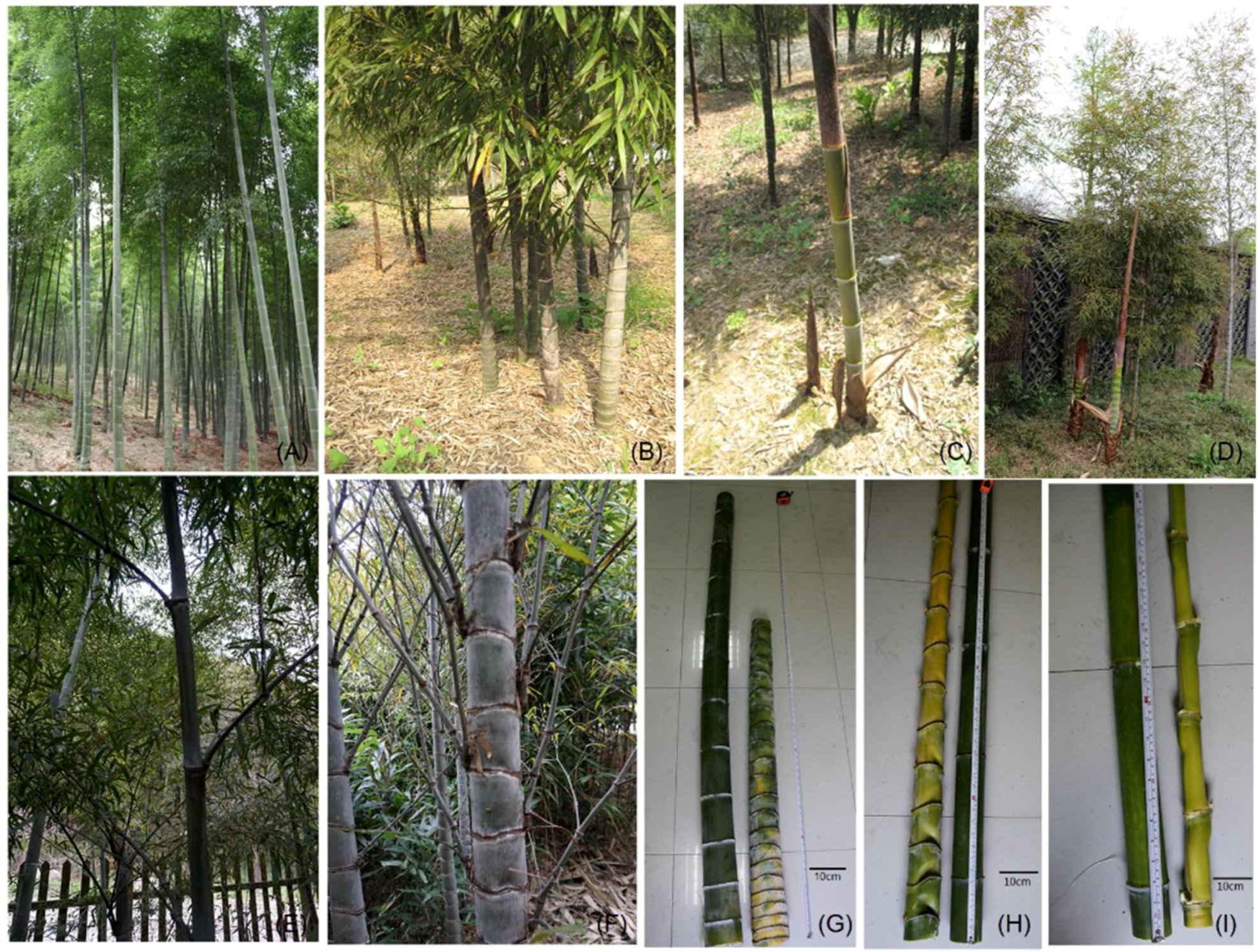
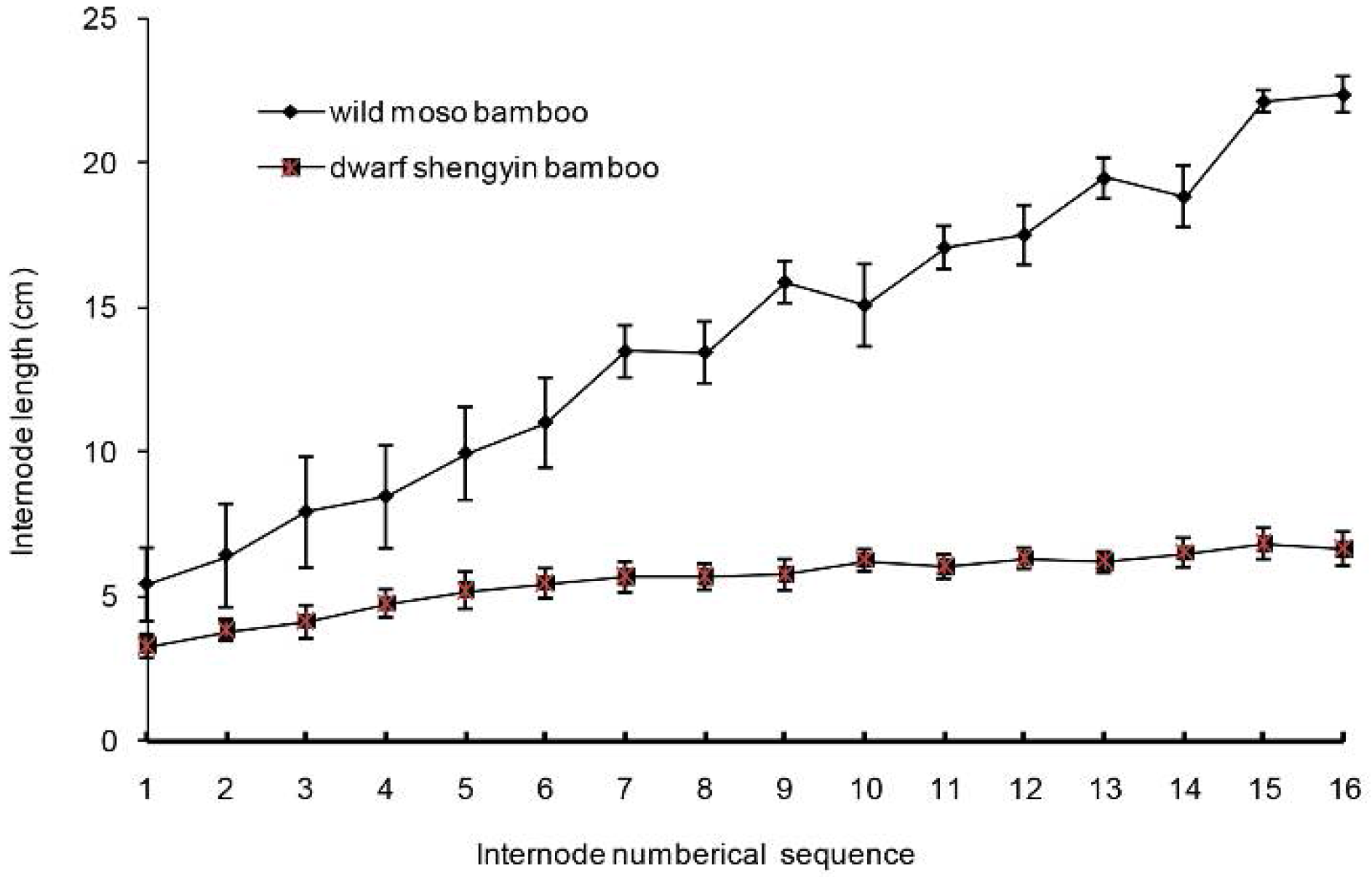


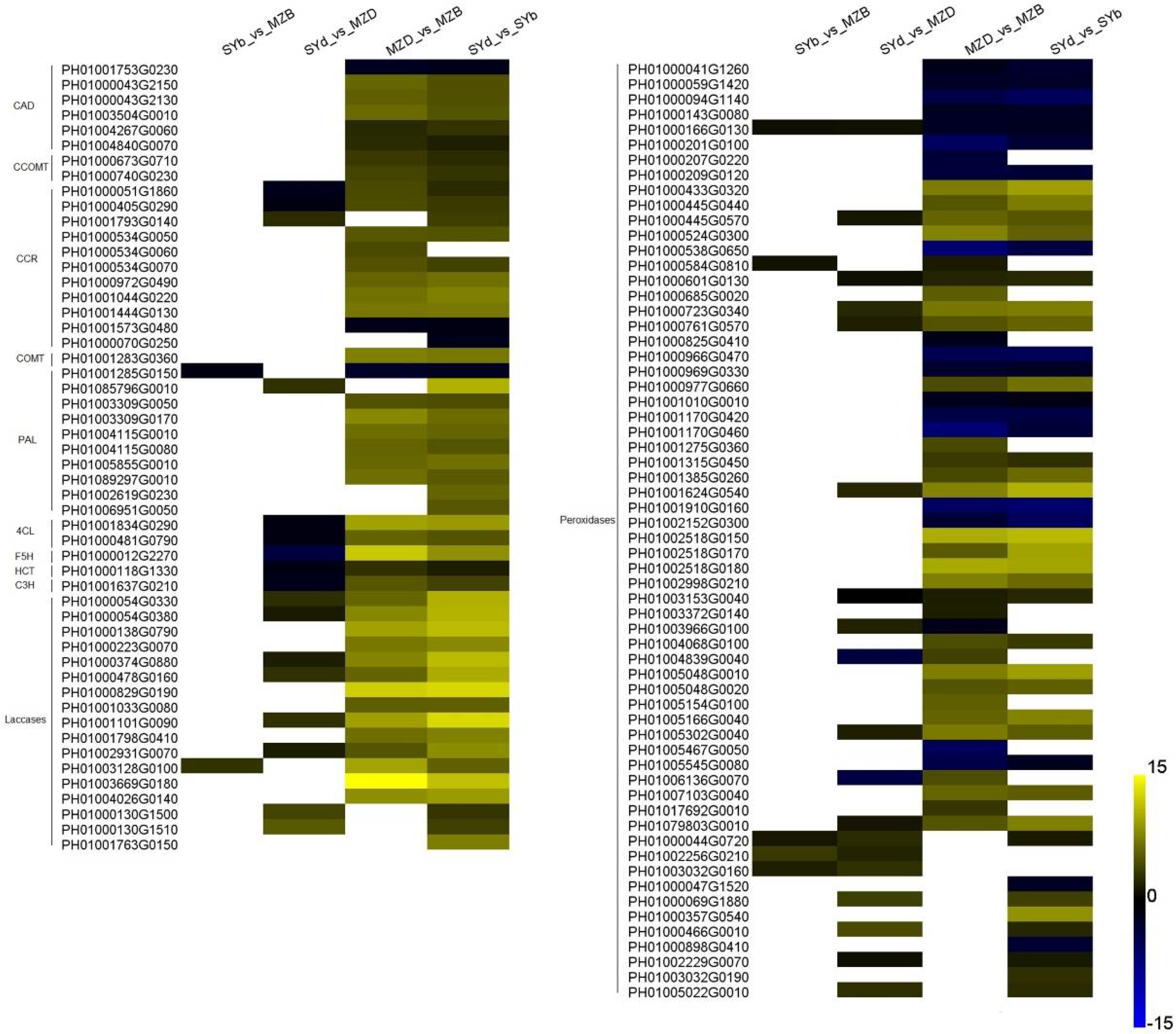
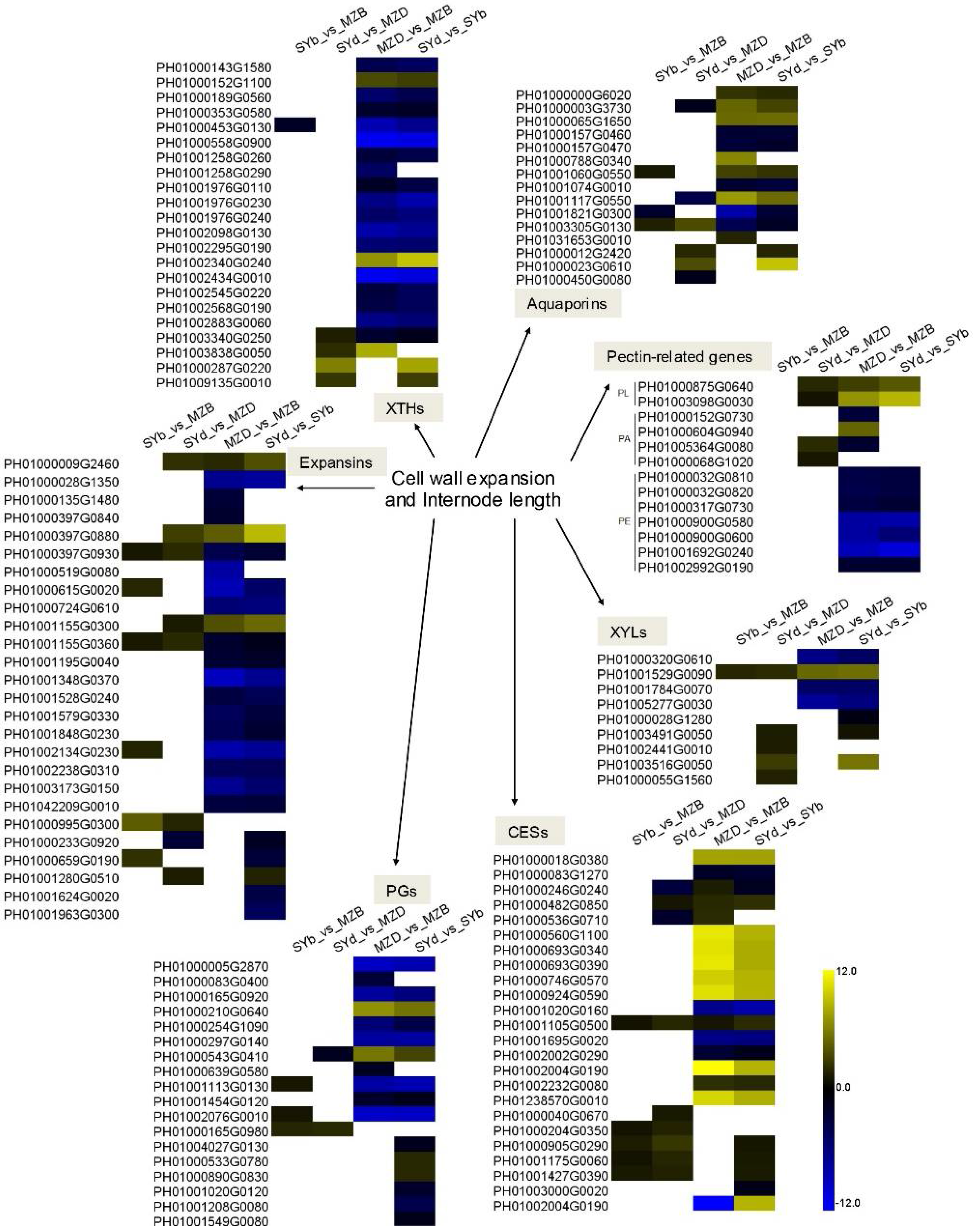
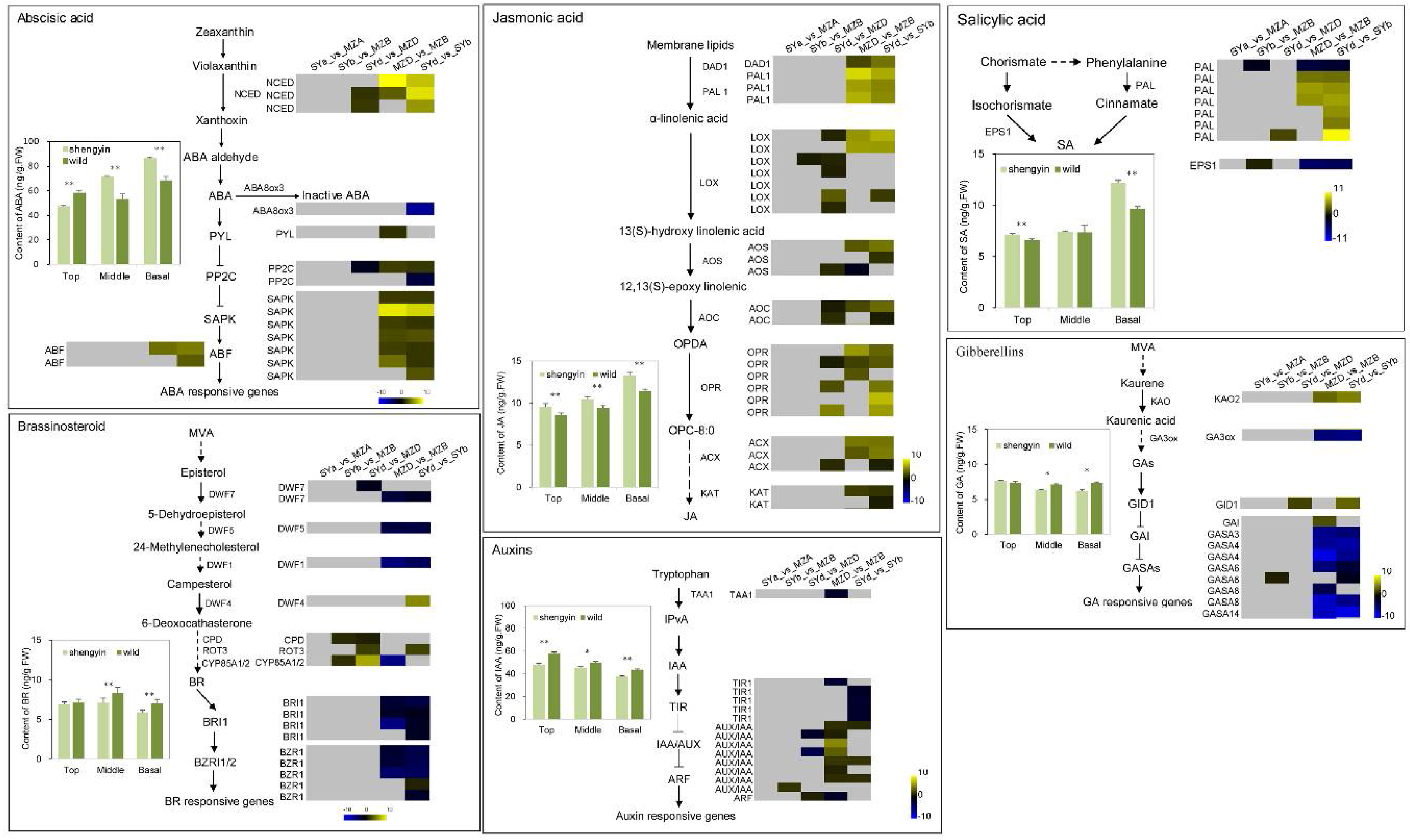
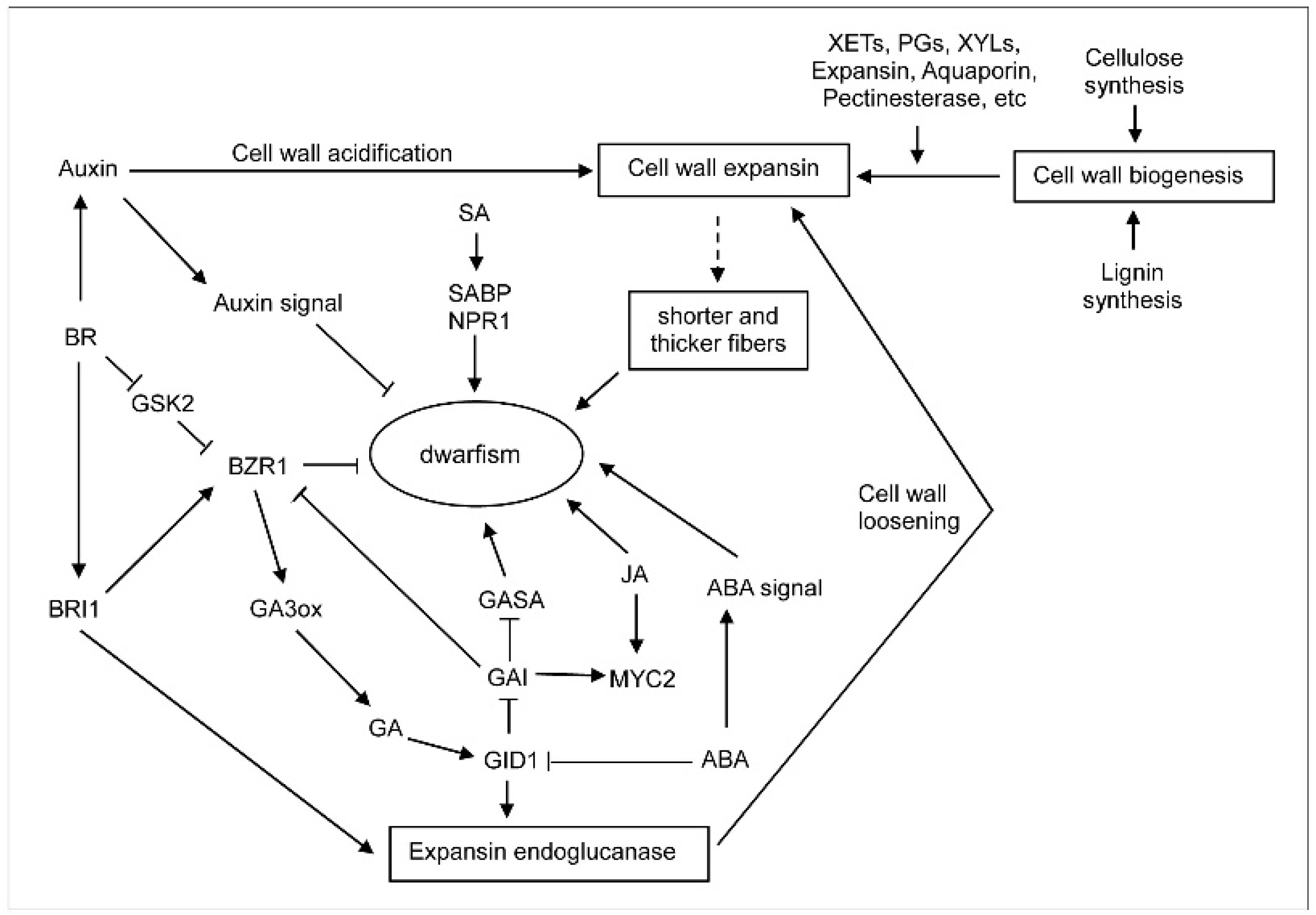
| Phenotypic Traits | Dwarf Shegnyin | Wild | p-Value |
|---|---|---|---|
| Plant height (cm) | 415.23 ± 28.63 | 914.21 ± 45.99 | 0.000 ** |
| Ground diameter (cm) | 4.23 ± 0.29 | 5.03 ± 0.3 | 0.000 ** |
| Diameter at breast height (cm) | 3.32 ± 0.11 | 4.18 ± 0.16 | 0.000 ** |
| Nodes of main stem | 35.37 ± 1.49 | 36.47 ± 2.17 | 0.056 |
| Nodes under branch | 19.11 ± 2.69 | 20.37 ± 2.78 | 0.083 |
| Branch angle (°) | 31.56 ± 4.64 | 41.39 ± 4.31 | 0.000 ** |
| Index | Position | Dwarf Shengyin | Wild | p-Value |
|---|---|---|---|---|
| Vascular bundle density | Top part | 411.41 ± 18.06 | 405.78 ± 21.41 | 0.118 |
| Middle part | 373.59 ± 11.59 | 367.34 ± 13.68 | 0.051 | |
| Basal part | 227.97 ± 10.84 | 231.56 ± 15.99 | 0.089 | |
| Vascular bundle length (μm) | Top part | 245.26 ± 9.88 | 257.17 ± 29.26 | 0.0345 * |
| Middle part | 293.59 ± 20.3 | 314.09 ± 22.54 | 0.0451 * | |
| Basal part | 430.39 ± 42.25 | 436.57 ± 12.68 | 0.689 | |
| Vascular bundle width (μm) | Top part | 176.08 ± 19.35 | 186.09 ± 21.32 | 0.694 |
| Middle part | 200.34 ± 20.19 | 207.67 ± 17.73 | 0.782 | |
| Basal part | 234.76 ± 19.07 | 243.15 ± 20.2 | 0.764 | |
| Length-width ratio of vascular bundle | Top part | 1.41 ± 0.15 | 1.39 ± 0.16 | 0.581 |
| Middle part | 1.48 ± 0.16 | 1.53 ± 0.19 | 0.671 | |
| Basal part | 1.84 ± 0.16 | 1.81 ± 0.15 | 0.801 |
| Dwarf Shengyin | Wild | p-Value | |||||||
|---|---|---|---|---|---|---|---|---|---|
| Internode | Top | Middle | Basal | Average | Top | Middle | Basal | Average | |
| LN (mm) | 0.336 | 0.343 | 0.331 | 0.337 | 0.335 | 0.443 | 0.294 | 0.357 | 0.282 |
| LW (mm) | 0.526 | 0.542 | 0.509 | 0.527 | 0.723 | 0.924 | 0.607 | 0.751 | 0.000 ** |
| LWW (mm) | 0.796 | 0.803 | 0.738 | 0.780 | 1.357 | 1.639 | 1.169 | 1.388 | 0.000 ** |
| Fine Fiber Percent (%) | 29.396 | 28.567 | 28.702 | 28.888 | 47.004 | 41.638 | 49.638 | 46.093 | 0.000 ** |
| Width (µm) | 17.911 | 20.956 | 19.344 | 19.404 | 14.944 | 14.878 | 15.256 | 15.026 | 0.000 ** |
| Sample | Raw Reads (bp) | Clean Reads (bp) | Clean Bases | Error Rate (%) | Q20 (%) | Q30 (%) | GC Content (%) |
|---|---|---|---|---|---|---|---|
| Dwarf shengyin_top (SYa) | 43,415,772 | 42,548,904 | 4.26 Gb | 0 | 100 | 100 | 51.68 |
| Dwarf shengyin_middle (SYb) | 45,744,478 | 45,148,166 | 4.51 Gb | 0 | 100 | 100 | 51.51 |
| Dwarf shengyin_basal (SYd) | 41,475,324 | 40,879,456 | 4.09 Gb | 0 | 100 | 100 | 53.43 |
| Wild_top (MZA) | 42,958,664 | 42,324,442 | 4.24 Gb | 0 | 100 | 100 | 51.89 |
| Wild_middle (MZB) | 40,210,766 | 40,116,284 | 4.01 Gb | 0 | 100 | 100 | 50.97 |
| Wild_basal (MZD) | 37,975,966 | 37,871,040 | 3.79 Gb | 0 | 100 | 100 | 54.53 |
© 2018 by the authors. Licensee MDPI, Basel, Switzerland. This article is an open access article distributed under the terms and conditions of the Creative Commons Attribution (CC BY) license (http://creativecommons.org/licenses/by/4.0/).
Share and Cite
Wang, T.; Liu, L.; Wang, X.; Liang, L.; Yue, J.; Li, L. Comparative Analyses of Anatomical Structure, Phytohormone Levels, and Gene Expression Profiles Reveal Potential Dwarfing Mechanisms in Shengyin Bamboo (Phyllostachys edulis f. tubaeformis). Int. J. Mol. Sci. 2018, 19, 1697. https://doi.org/10.3390/ijms19061697
Wang T, Liu L, Wang X, Liang L, Yue J, Li L. Comparative Analyses of Anatomical Structure, Phytohormone Levels, and Gene Expression Profiles Reveal Potential Dwarfing Mechanisms in Shengyin Bamboo (Phyllostachys edulis f. tubaeformis). International Journal of Molecular Sciences. 2018; 19(6):1697. https://doi.org/10.3390/ijms19061697
Chicago/Turabian StyleWang, Tao, Lei Liu, Xiaojing Wang, Lixiong Liang, Jinjun Yue, and Lubin Li. 2018. "Comparative Analyses of Anatomical Structure, Phytohormone Levels, and Gene Expression Profiles Reveal Potential Dwarfing Mechanisms in Shengyin Bamboo (Phyllostachys edulis f. tubaeformis)" International Journal of Molecular Sciences 19, no. 6: 1697. https://doi.org/10.3390/ijms19061697
APA StyleWang, T., Liu, L., Wang, X., Liang, L., Yue, J., & Li, L. (2018). Comparative Analyses of Anatomical Structure, Phytohormone Levels, and Gene Expression Profiles Reveal Potential Dwarfing Mechanisms in Shengyin Bamboo (Phyllostachys edulis f. tubaeformis). International Journal of Molecular Sciences, 19(6), 1697. https://doi.org/10.3390/ijms19061697




